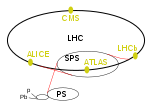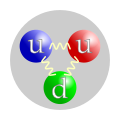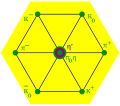In particle physics, a hadron (/ˈhædrɒn/ ; from Ancient Greek ἁδρός (hadrós) 'stout, thick') is a composite subatomic particle made of two or more quarks...
15 KB (1,839 words) - 04:52, 8 December 2024
The Large Hadron Collider (LHC) is the world's largest and highest-energy particle accelerator. It was built by the European Organization for Nuclear Research...
110 KB (10,931 words) - 00:19, 24 December 2024
physics by colliding hadrons. A hadron collider uses tunnels to accelerate, store, and collide two particle beams. Only a few hadron colliders have been...
1 KB (113 words) - 15:14, 5 January 2025
epoch to bind together into hadrons. Initially, the temperature was high enough to allow the formation of hadron/anti-hadron pairs, which kept matter and...
2 KB (268 words) - 06:34, 2 January 2025
Exotic hadrons are subatomic particles composed of quarks and gluons, but which – unlike "well-known" hadrons such as protons, neutrons and mesons – consist...
9 KB (882 words) - 20:14, 17 August 2024
Strong interaction (section Within hadrons)
fundamental interaction that confines quarks into protons, neutrons, and other hadron particles. The strong interaction also binds neutrons and protons to create...
18 KB (2,003 words) - 18:30, 10 December 2024
CERN (section Large Hadron Collider)
CERN through international collaborations. CERN is the site of the Large Hadron Collider (LHC), the world's largest and highest-energy particle collider...
118 KB (10,636 words) - 18:39, 30 December 2024
In particle physics, the parton model is a model of hadrons, such as protons and neutrons, proposed by Richard Feynman. It is useful for interpreting...
17 KB (1,850 words) - 13:44, 29 November 2024
The Very Large Hadron Collider (VLHC) was a proposed future hadron collider planned to be located at Fermilab. The VLHC was planned to be located in a...
5 KB (477 words) - 17:20, 5 March 2023
constituent of matter. Quarks combine to form composite particles called hadrons, the most stable of which are protons and neutrons, the components of atomic...
77 KB (7,572 words) - 15:22, 18 December 2024
Hadron spectroscopy is the subfield of particle physics that studies the masses and decays of hadrons. Hadron spectroscopy is also an important part of...
2 KB (203 words) - 14:15, 9 December 2024
HERA (particle accelerator) (redirect from Hadron-Electron Ring Accelerator)
HERA (German: Hadron-Elektron-Ringanlage, English: Hadron–Electron Ring Accelerator) was a particle accelerator at DESY in Hamburg. It was operated from...
11 KB (1,275 words) - 08:13, 26 October 2024
Quark model (redirect from Simple quark model of hadrons)
classification scheme for hadrons in terms of their valence quarks—the quarks and antiquarks that give rise to the quantum numbers of the hadrons. The quark model...
20 KB (2,576 words) - 15:01, 8 January 2025
HARP, the Hadron Production Experiment, also referred to as the PS214 experiment, at the Proton Synchrotron was a physics experiment at CERN that took...
2 KB (198 words) - 00:54, 24 June 2023
Katherine McAlpine (redirect from Large Hadron Rap)
CERN, McAlpine wrote, produced and performed in the YouTube video "Large Hadron Rap" under the pseudonym "alpinekat". As of September 2018, the video has...
7 KB (637 words) - 08:15, 21 October 2024
the strong interaction. Quarks cannot exist on their own but form hadrons. Hadrons that contain an odd number of quarks are called baryons and those that...
42 KB (4,290 words) - 18:52, 8 January 2025
R-hadrons are hypothetical particles composed of a supersymmetric particle and at least one quark. Only a few of the current supersymmetry theories predict...
6 KB (977 words) - 00:08, 15 June 2023
List of particles (redirect from List of hadrons)
bound states of elementary particles. Hadrons are defined as strongly interacting composite particles. Hadrons are either: Composite fermions (especially...
24 KB (2,528 words) - 10:10, 20 January 2025
The Large Hadron Collider, at CERN, in operation from September 2008 The High Luminosity Large Hadron Collider (formerly the Super Large Hadron Collider)...
2 KB (275 words) - 23:37, 27 July 2022
scattering is the name given to a process used to probe the insides of hadrons (particularly the baryons, such as protons and neutrons), using electrons...
9 KB (1,028 words) - 20:14, 17 August 2024
Tevatron, and the Large Hadron Collider (LHC). The FCC project is considering three scenarios for collision types: FCC-hh, for hadron-hadron collisions, including...
84 KB (5,758 words) - 04:31, 22 November 2024
Large Hadron Collider. Popular concerns have then been raised over end-of-the-world scenarios (see Safety of particle collisions at the Large Hadron Collider)...
25 KB (3,028 words) - 11:17, 18 July 2024
Subatomic particle (section Hadrons)
antiquarks) are called hadrons. Due to a property known as color confinement, quarks are never found singly but always occur in hadrons containing multiple...
35 KB (3,289 words) - 16:18, 16 January 2025
particle). Quarks and gluons must clump together to form hadrons. The two main types of hadron are the mesons (one quark, one antiquark) and the baryons...
11 KB (1,231 words) - 15:10, 5 January 2025
quarks into groups according to quantum chromodynamics (QCD), forming hadrons such as protons and neutrons. Gluons carry the color charge of the strong...
25 KB (2,632 words) - 07:59, 22 September 2024
process occurs in high energy hadron–hadron scattering. It takes place when a quark of one hadron and an antiquark of another hadron annihilate, creating a virtual...
11 KB (1,568 words) - 16:04, 2 January 2025
Safety of high-energy particle collision experiments (redirect from Safety of the Large Hadron Collider)
time when the Relativistic Heavy Ion Collider (RHIC) and later the Large Hadron Collider (LHC)—currently the world's largest and most powerful particle...
56 KB (6,252 words) - 14:18, 2 November 2024
The European Physical Journal A: Hadrons and Nuclei is an academic journal, recognized by the European Physical Society, presenting new and original research...
2 KB (173 words) - 12:51, 6 January 2025
Transverse momentum distributions (category Hadrons)
specifically in hadron-beam scattering experiments, transverse momentum distributions (TMDs) are the distributions of the hadron's quark or gluon momenta...
11 KB (1,626 words) - 16:36, 5 January 2025



















